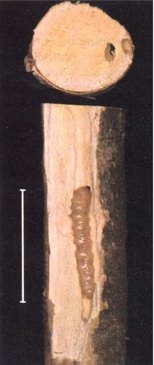PESTS AND DISEASES OF FORESTRY IN NEW ZEALAND
Lemon-tree borer
Scion is the leading provider of forest-related knowledge in New Zealand
Formerly known as the Forest Research Institute, Scion has been a leader in research relating to forest health for over 50 years. The Rotorua-based Crown Research Institute continues to provide science that will protect all forests from damage caused by insect pests, pathogens and weeds. The information presented below arises from these research activities.
Forest and Timber Insects in New Zealand No. 31: Lemon tree borer
Revised 2009
Based on G.P. Hosking (1978)
Insect: Oemona hirta (F.) (Coleoptera: Cerambycidae)

Fig. 1 - Lemon-tree borer adult.
The line shows natural length.
Type of injury
The larvae of the lemon-tree borer tunnel into the sapwood of living trees and cause two main types of damage. The first is seen about December when small twigs are mined and killed by the young larvae. The second type is present throughout the year with larvae mining in the larger branches and in the main stem. The tunnels of both young and older larvae are oval in cross section and clear of bore dust. Occasionally a larva may girdle a branch just beneath the bark, causing it to break.
Hosts
This insect attacks a wide range of native and exotic hardwoods. Softwoods are only very rarely attacked.
Distribution
The lemon-tree borer is a native insect found throughout New Zealand, although it is uncommon in very dry areas.
Economic importance
This insect is best known as a serious pest of citrus trees but also causes damage to ornamental trees and shrubs. Its main forestry significance is in poplar nurseries where it girdles the living stumps used for the production of cuttings.
Description, life history, and habits
The adults are longhorn beetles which vary from red-brown to almost black and are covered with yellowish white hairs lying flat against the body (Fig. 1). The head projects downward and bears two small patches of dense yellowish orange hair between and below the eyes. The antennae are slender and about as long as the body. The thorax is barrel-shaped, narrower than the elytra (wing cases), and bears about 10 irregular transverse ridges with short off-white hairs between them. The elytra are almost parallel-sided for most of their length and have numerous long hairs arising from shallow punctures over their entire surface. Between the elytra where they join the prothorax is a small shield-shaped area of dense yellowish orange hair. The legs are long and covered with short yellowish white hair. Overall length varies from 15 to 25 mm and width at the base of the elytra from 3 to 6 mm.
The larva (Fig. 2) is white, cylindrical, and 25 to 40 mm long with gouge-like jaws. Each thoracic and abdominal segment has a swollen transverse ridge. Long brown hairs are present on the prothorax and on the sides of the other two thoracic segments and all the abdominal segments.

Fig. 2 - Larva of the lemon-tree borer in living Nematolepis squamea (syn. Phebalium billardierei).
The line shows natural length.
The whitish waxy eggs are laid in crevices, cicada scars, and damaged bark, usually on small twigs but also on larger branches and main stems. The larvae hatch after a few days and those on twigs generally mine towards the main stem. On reaching wood of about 10 to 20 mm diameter the larva occasionally excavates a tunnel spiralling around the branch just beneath the bark.
The larva widens its tunnel every few centimetres and cuts a small round hole to the exterior which is used for the ejection of bore dust. This aerates the tunnels and stops them becoming overgrown with fungus in the moist conditions required by the larva. Although essentially borers in living wood, the larvae can survive in dead wood providing it is damp.
Pupation occurs in a short section of the larval tunnel plugged at each end with coarse wood-scrapings. The pupal period lasts about two to four weeks. The adults are nocturnal, attracted to light, and may be found from December to March.
Control
Affected branches of trees and shrubs should be cut back to healthy tissue, the infested material burnt, and cut ends painted to prevent re-infestation. The probability of reinfestation may be reduced by the removal of alternative host species from around orchards, nurseries, etc. The use of systemic insecticides in orchards is scarcely practicable because of the need for repeated costly applications. The injection of insecticides into bore-dust ejection holes may be of benefit in treating infestations in particularly valuable trees, but some insecticides may damage the plant. A few parasitoid wasps have been recorded attacking O. hirta. The most common is the ichneumonid, Xanthocryptus novozealandicus (Dalla Torre). The parasitic fungus, Cordyceps aemonae Lloyd, has also been recorded attacking the larvae.
Bibliography
Cottier, W. 1938: Citrus pests: (2) The citrus borer. New Zealand Journal of Agriculture 57 : 28-29.
Duffy, E.A.J. 1963: A monograph of the immature stages of Australasian timber beetles (Cerambycidae). British Museum, London. 235 p.
Hosking, G.P. 1978: Oemona hirta (Fabricius) (Coleoptera: Cerambycidae), Lemon-tree borer. New Zealand Forest Service, Forest and Timber Insects in New Zealand No. 31.
Hudson, G.V. 1934: New Zealand beetles and their larvae. Ferguson and Osborn, Wellington. 236 p.
This information is intended for general interest only. It is not intended to be a substitute for specific specialist advice on any matter and should not be relied on for that purpose. Scion will not be liable for any direct, indirect, incidental, special, consequential or exemplary damages, loss of profits, or any other intangible losses that result from using the information provided on this site.
(Scion is the trading name of the New Zealand Forest Research Institute Limited.)



